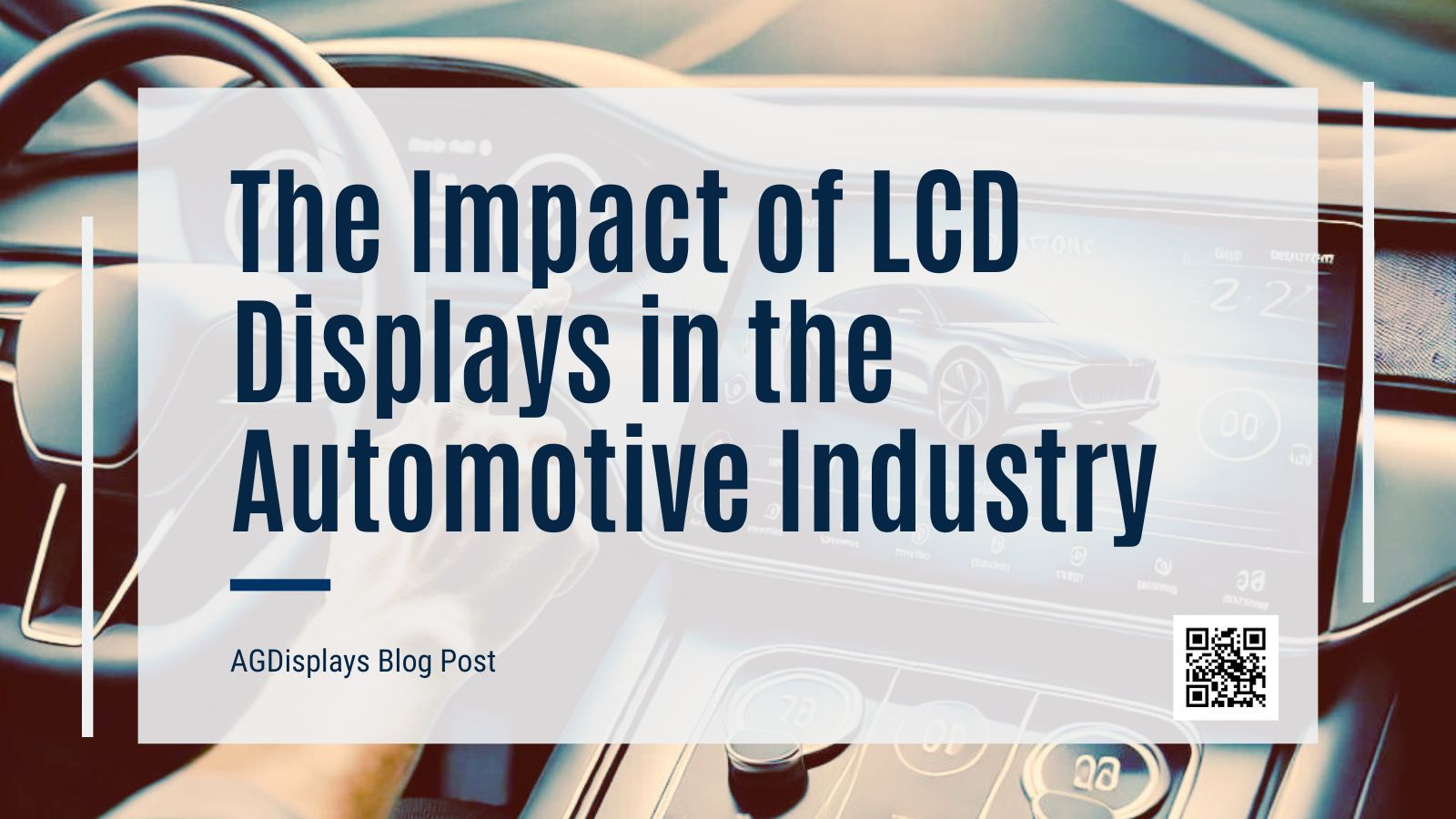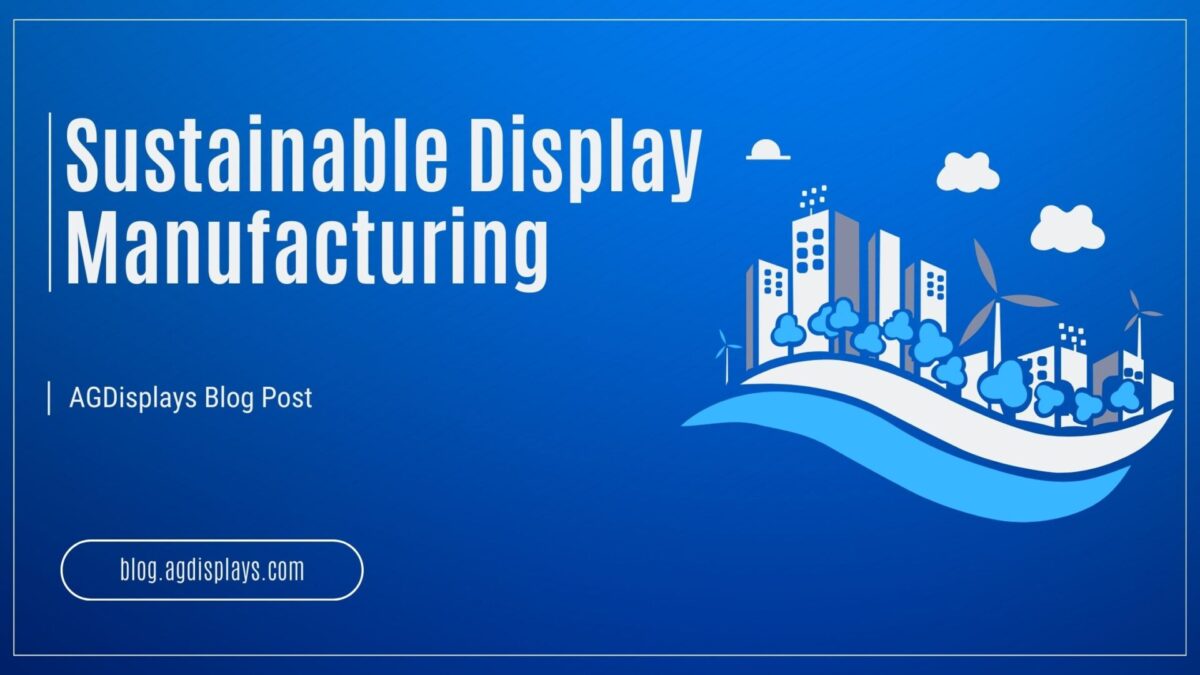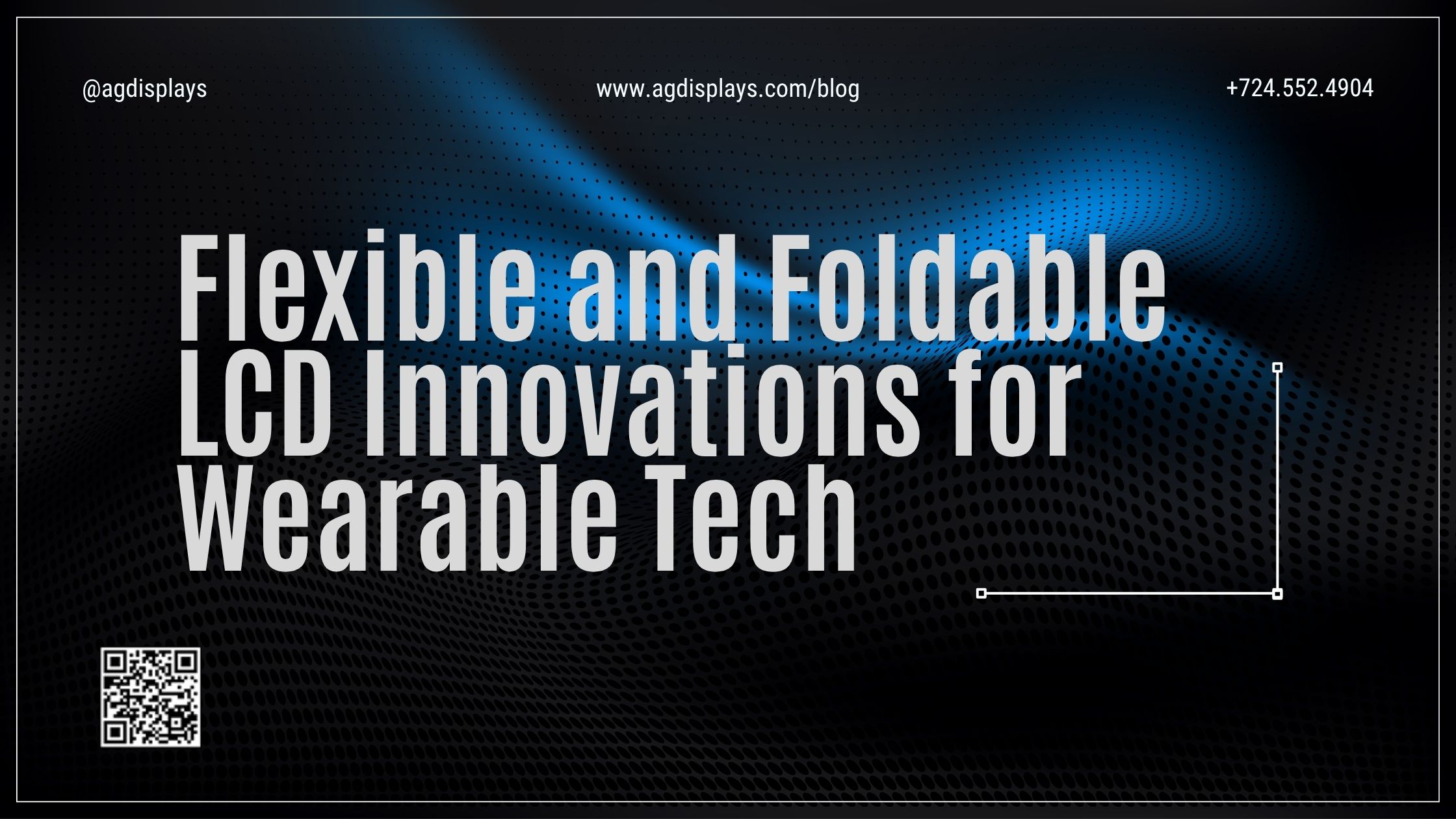The automotive industry has undergone several technological transformations over the past few decades, and one of the most significant innovations is the integration of Liquid Crystal Displays (LCDs). LCDs, initially introduced in consumer electronics, have become a core component of modern vehicles, reshaping everything from dashboard interfaces to entertainment systems and providing drivers and passengers with a more dynamic, safer, and interactive driving experience. This blog delves into the history, technological advancements, types of LCDs in automotive applications, and the future of this technology, as well as exploring the benefits and value enhancements that companies like AGDisplays offer to manufacturers and customers alike.
History of LCD Use in the Automotive Industry
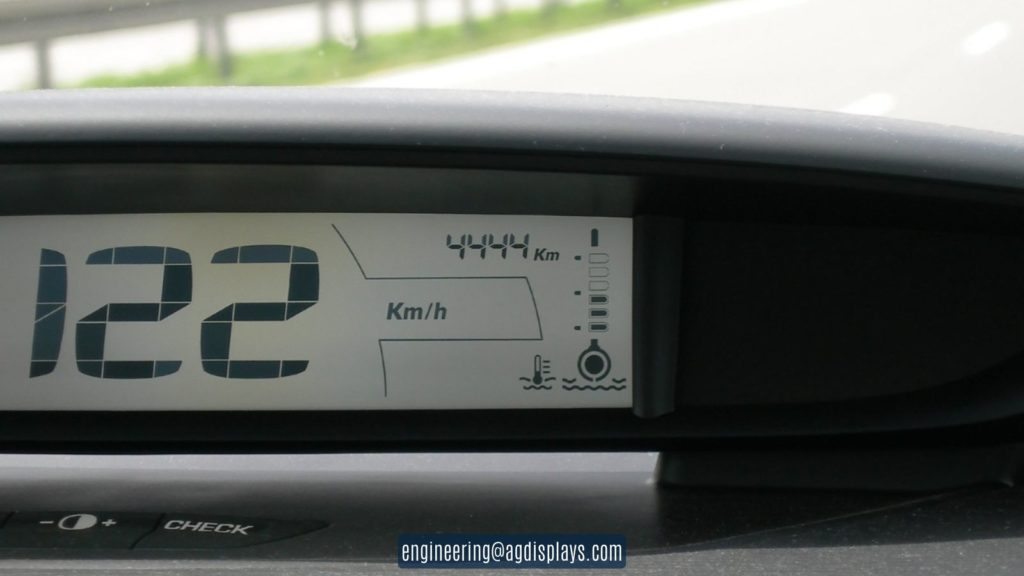
Early Beginnings (1980s – 1990s)
The first LCDs appeared in automotive applications in the late 1980s and early 1990s. At this stage, LCDs were primarily used in simple digital clocks, odometers, and basic information displays. These early versions were monochromatic, featuring simple alphanumeric displays with low resolution. They were a novelty at the time, primarily driven by the need to digitize the driver’s interface and replace mechanical or analog systems. Automakers began adopting these early LCDs because they were lightweight, offered lower power consumption than competing technologies like cathode-ray tubes (CRTs), and provided a cleaner, more modern aesthetic.
LCD Growth in the 2000s
As the 2000s approached, LCD technology experienced significant advancements. The demand for more advanced in-car displays began to rise, driven by the growing prevalence of GPS navigation systems and digital entertainment. Automakers introduced color LCD screens, which could display maps, menus, and vehicle diagnostics. The mid-2000s marked a shift as LCDs started to replace analog gauges entirely, leading to digital instrument clusters, which combined information like speed, fuel levels, and warning indicators into a sleek digital interface.
The 2010s: Touchscreen and Infotainment Systems
The next major leap in automotive displays came in the 2010s with the mass integration of touchscreens. Companies like Tesla helped lead the charge by replacing physical buttons and knobs with large central LCD screens that controlled everything from climate control to media playback. This shift aligned with broader trends in consumer electronics, as users had become accustomed to touch interactions from smartphones and tablets. The automotive LCD market exploded during this time, with virtually every automaker integrating some form of high-resolution, full-color touchscreen in their vehicles.
Technological Innovations in Automotive LCDs
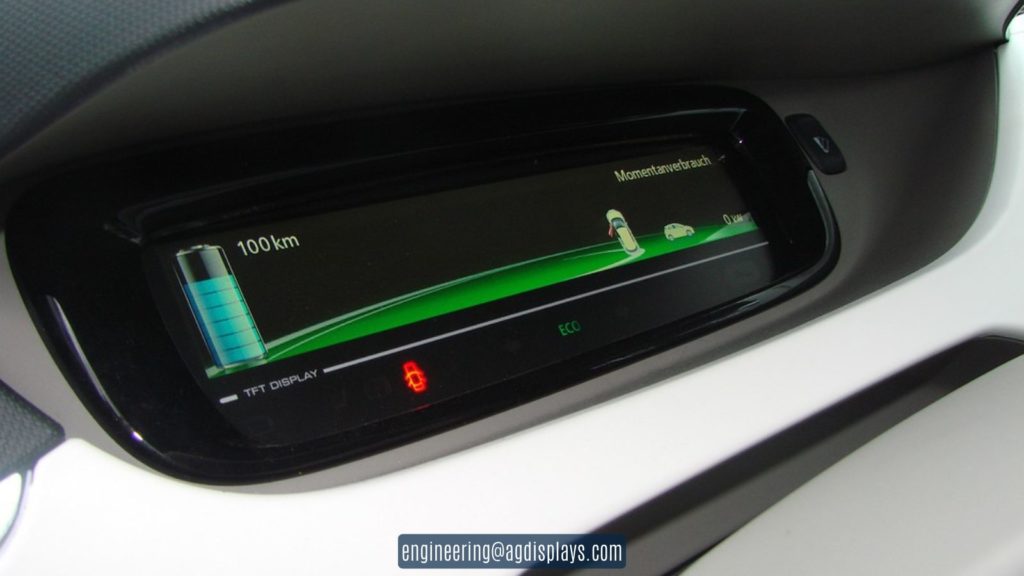
Resolution and Display Quality
One of the key technological innovations in automotive LCDs is the improvement in display resolution. Early displays were limited in pixel density, but today’s LCDs can support Full HD (1920×1080) or even 4K (3840×2160) resolution. Higher resolutions are essential for delivering sharper images, which is particularly important for navigation systems and safety features like reverse cameras. High-resolution displays enhance readability and clarity, making critical information more accessible to the driver.
Advanced Backlighting Technology
Initially, automotive LCDs used Cold Cathode Fluorescent Lamps (CCFL) for backlighting. However, this technology was inefficient, particularly in terms of power consumption and heat output. The introduction of LED (Light Emitting Diode) backlighting greatly improved the efficiency and lifespan of automotive displays. LED backlighting allowed for better brightness control, which is crucial for maintaining display visibility in various lighting conditions, such as bright sunlight or nighttime driving.
Integration of Capacitive Touch Technology
Capacitive touch technology, the same technology used in smartphones, became a key innovation in automotive LCD displays. Unlike resistive touchscreens, which required pressure to register input, capacitive touchscreens could detect even the lightest touch. This improved both the user experience and the durability of the displays, as capacitive screens tend to have fewer mechanical components, reducing wear and tear.
In-Cell and On-Cell Touch Technologies
In-Cell and On-Cell touch technologies have streamlined the design of automotive LCDs by integrating touch sensors directly into the display layer. This reduces the thickness and weight of the screen, a critical factor in automotive design, where space and weight are premium considerations. These technologies also improve the overall responsiveness and durability of the touch display.
Types of LCD Displays in the Automotive Industry
The automotive industry makes use of various types of LCD displays, each optimized for specific applications:
TFT-LCD (Thin Film Transistor LCD)
TFT-LCDs are the most commonly used displays in modern vehicles. They offer high contrast, fast response times, and excellent color reproduction. TFT-LCDs are used in infotainment systems, instrument clusters, and heads-up displays (HUDs). Their robustness and flexibility make them ideal for a wide range of automotive applications.
IPS-LCD (In-Plane Switching)
IPS-LCDs have become increasingly popular for high-end automotive applications. They offer superior viewing angles and better color accuracy than standard TFT-LCDs, making them ideal for larger displays that need to be viewed from multiple angles. IPS-LCDs are commonly found in larger central touchscreens and premium dashboards.
Flexible LCDs
Flexible LCDs are an emerging technology in the automotive space. These displays can be bent or curved, allowing automakers to design more ergonomic and aesthetically pleasing interfaces. Flexible LCDs are used in futuristic dashboard designs that wrap around the driver, providing a more immersive experience.
Transparent LCDs
Although still in the early stages of adoption, transparent LCDs hold promise for use in augmented reality heads-up displays (HUDs). These displays overlay critical information, such as speed, navigation, and collision warnings, directly onto the windshield, allowing the driver to keep their eyes on the road.
The Future of Automotive LCD Technology
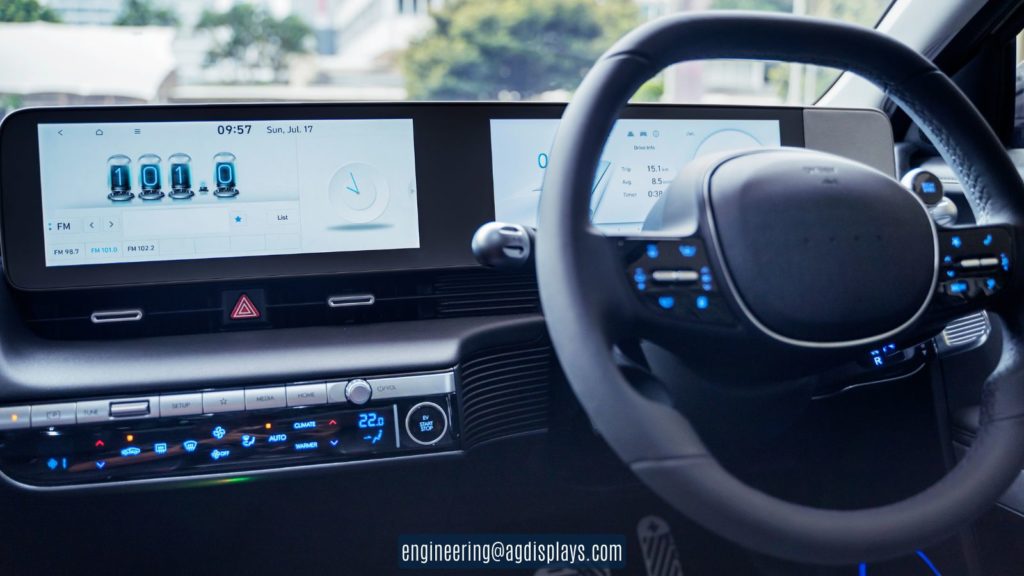
The future of LCD technology in the automotive industry looks bright, with several trends poised to drive continued innovation:
Augmented Reality (AR) Displays
Augmented reality is expected to revolutionize the driving experience. AR-enabled HUDs will allow drivers to see real-time information such as navigation arrows or hazard warnings projected onto the road ahead. AR displays could also be integrated with advanced driver assistance systems (ADAS), making driving safer and more intuitive.
OLED (Organic Light-Emitting Diode) Integration
While OLED displays are not yet widespread in the automotive industry due to cost and durability concerns, they are expected to become more prevalent in the coming years. OLEDs offer superior contrast ratios, faster response times, and better energy efficiency compared to traditional LCDs. Their flexibility and thinness make them suitable for next-generation dashboard designs.
3D and Holographic Displays
Some automakers are experimenting with 3D and holographic displays to create more engaging user interfaces. These displays could add depth and realism to navigation systems and instrument clusters, providing drivers with more intuitive, visually appealing ways to interact with their vehicle.
Smart Surfaces
Future LCD technology may evolve into smart surfaces, where entire sections of the car’s interior, such as the dashboard or even the windows, can function as interactive displays. This would provide automakers with nearly unlimited design possibilities while enhancing the driver’s ability to interact with the vehicle.
Value Enhancements of Automotive LCDs
LCD displays in vehicles do more than simply offer a way to convey information; they add significant value in multiple areas:
Safety
Modern LCD displays integrate with ADAS (Advanced Driver Assistance Systems), which include features such as lane-keeping assistance, collision avoidance, and blind-spot monitoring. These systems rely on clear, responsive displays to alert drivers to potential hazards, helping to prevent accidents and saving lives.
Driver Experience
The proliferation of larger, higher-quality displays has improved the overall driving experience. Intuitive touchscreens, combined with voice control and gesture recognition, have made it easier for drivers to control navigation, audio, and other in-car systems without distraction.
Customization
With the rise of digital instrument clusters and customizable displays, drivers can now personalize the information they see based on their preferences. This includes customizable layouts, colors, and even themes, which cater to the growing consumer demand for personalized experiences.
In-Car Entertainment
LCDs provide a superior platform for delivering in-car entertainment, including HD video streaming, games, and connectivity features. Rear-seat entertainment systems, often integrated into the headrests or roof-mounted displays, offer passengers a more enjoyable ride, especially on long trips.
Efficiency
LCDs contribute to the efficiency of electric vehicles (EVs) by providing real-time data on energy consumption, range, and battery status. High-efficiency displays also minimize power draw, which is critical for maintaining the overall energy efficiency of EVs.
For more info about Transportation related LCD displays, read our eBook
Statistics and Figures
The integration of LCD displays into the automotive industry has seen rapid growth over the past decade. These displays are not only improving user experience and safety, but also driving significant economic impact within the industry. Below are some key statistics and figures that highlight the current state and projected growth of LCD displays in vehicles:
Market Growth of Automotive Displays
The global automotive display market was valued at approximately $13.65 billion in 2022, and it is projected to grow at a compound annual growth rate (CAGR) of 8.3% from 2023 to 2030, reaching an estimated value of $24.9 billion by 2030. This rapid growth is fueled by increasing demand for digital instrument clusters, touchscreens, and heads-up displays (HUDs) as automakers continue to prioritize advanced display technologies in both premium and mass-market vehicles.
Increase in Screen Size
In recent years, there has been a significant shift toward larger screens in vehicles. By 2023, the average size of center console displays in vehicles had grown to 7 to 12 inches, compared to the more typical 4- to 6-inch displays seen in previous decades. High-end vehicles have even larger displays, with Tesla leading the charge with screens as large as 15 inches in their Model S and Model X vehicles.
Rise of Touchscreen Adoption
The adoption rate of touchscreens in new cars has skyrocketed. As of 2023, over 95% of new vehicles sold globally include at least one LCD touchscreen, up from around 40% in 2015. This is driven by the transition away from physical buttons and dials toward more flexible, software-based control systems that enhance the user interface experience.
Instrument Cluster Digitalization
The global adoption of digital instrument clusters—where traditional analog gauges are replaced by LCD screens—is another trend driving the growth of automotive displays. By 2022, more than 70% of newly manufactured vehicles featured fully digital instrument clusters. This number is expected to increase to nearly 90% by 2027, as manufacturers continue to phase out traditional gauge designs.
Increased Demand for Advanced Displays in Electric Vehicles (EVs)
Electric vehicles (EVs) are a major driver of LCD demand due to their focus on futuristic, technology-driven interiors. In 2023, 80% of all electric vehicles included advanced LCDs in their dashboards and infotainment systems, compared to 60% in 2018. Electric vehicles often feature larger and more sophisticated displays to showcase vehicle performance metrics like range, battery health, and energy consumption, contributing to higher LCD integration.
Regional Market Breakdown
The automotive display market is growing globally, but some regions are leading the charge. As of 2022, Asia-Pacific accounted for over 45% of the global automotive display market, driven by the production activities of automakers in Japan, South Korea, and China. In comparison, North America held approximately 30%, and Europe followed closely with about 20% of the market share. This geographical distribution reflects the dominance of key automotive markets and their strong consumer demand for cutting-edge technology in vehicles.
Technological Penetration in Heads-Up Displays (HUDs)
Heads-up displays (HUDs), another important segment of the automotive display market, have grown in prominence. As of 2023, 1 in 3 new cars sold globally feature HUD technology, either as a standard or optional feature. With advancements in augmented reality (AR), HUDs are expected to see a CAGR of 21.2% through 2028, as more automakers integrate AR capabilities to enhance driver safety and convenience.
Energy Efficiency and Environmental Impact
Modern LCD displays in vehicles have become significantly more energy-efficient over the past decade. For example, the shift from traditional CCFL backlighting to LED backlighting in automotive LCDs has resulted in energy savings of 20-30% per display. This improvement is particularly important for electric vehicles, where conserving battery power is critical. Additionally, advances in LCD production techniques have reduced the environmental impact of display manufacturing, with many automakers sourcing materials from suppliers that focus on sustainability.
The Role of LCD Integrators like AGDisplays

LCD integrators like AGDisplays play a crucial role in enhancing the value of automotive displays. By offering services that cater to the specific needs of automotive manufacturers, AGDisplays helps deliver customized, high-quality LCD solutions that meet the demanding standards of the automotive industry.
Custom Solutions
AGDisplays provides custom LCD solutions tailored to the automotive sector, including ruggedized displays that can withstand the harsh environments vehicles often encounter. Whether the requirements are for glare reduction, sunlight readability, or enhanced durability, AGDisplays offers modifications that meet these needs.
Optical Bonding
One of AGDisplays’ key services is optical bonding, a process that enhances the durability, readability, and performance of LCDs. This technology helps eliminate air gaps between the LCD and the cover glass, reducing reflection and improving contrast, making displays easier to read in bright sunlight. Optical bonding also improves the structural integrity of the display, increasing its resistance to vibration and shock—critical for automotive applications.
Extended Temperature Ranges
Automotive environments experience a wide range of temperatures, from freezing cold in winter to scorching heat in summer. AGDisplays offers solutions that ensure displays function reliably across these temperature extremes, maintaining performance and extending the display’s lifespan.
Display Testing and Quality Control
AGDisplays provides thorough testing and quality control services to ensure that each display meets stringent automotive standards. This includes environmental testing for temperature, humidity, and vibration, as well as rigorous optical performance tests to guarantee clarity, brightness, and contrast.
Consultation and Support
From the design phase to post-production, AGDisplays works closely with automotive manufacturers to provide technical consultation and support. This helps manufacturers integrate the latest LCD technologies into their vehicles while ensuring that the displays perform optimally under real-world conditions.
Conclusion
LCD displays have become an indispensable part of modern automotive design, influencing not only how drivers interact with their vehicles but also the safety, efficiency, and overall driving experience. As LCD technology continues to advance, we can expect even more sophisticated displays, such as augmented reality and OLED screens, to shape the future of automotive interiors. Companies like AGDisplays are at the forefront of this transformation, offering valuable services that enhance the performance and longevity of automotive LCDs. With their expertise in customization, optical bonding, and quality control, AGDisplays ensures that automotive displays meet the highest standards of durability and performance, helping manufacturers stay ahead in an increasingly competitive market.
To view our latest displays and products, visit our Shopify store: https://shop.agdisplays.com/











